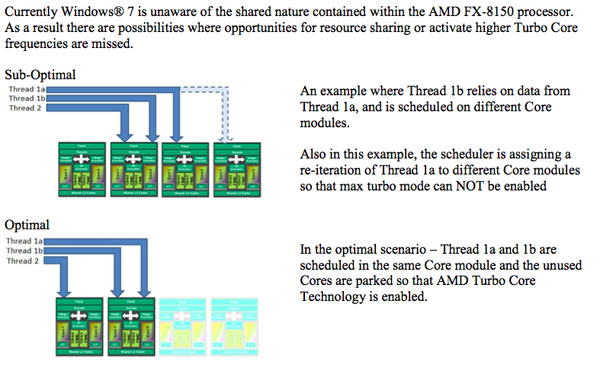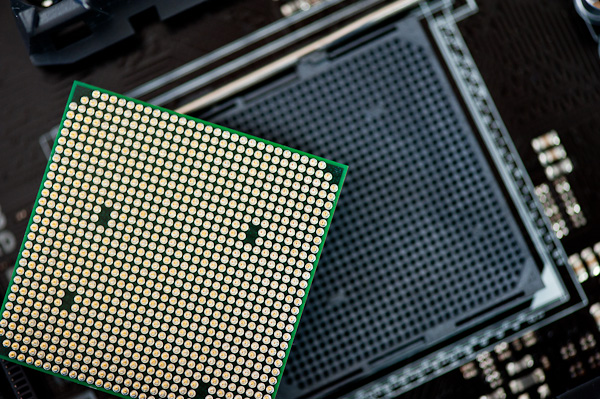The Bulldozer Review: AMD FX-8150 Tested
by Anand Lal Shimpi on October 12, 2011 1:27 AM ESTFinal Words
In many cases, AMD's FX-8150 is able to close the gap between the Phenom II X6 and Intel's Core i5 2500K. Given the right workload, Bulldozer is actually able to hang with Intel's fastest Sandy Bridge parts. We finally have a high-end AMD CPU with power gating as well as a very functional Turbo Core mode. Unfortunately the same complaints we've had about AMD's processors over the past few years still apply here today: in lightly threaded scenarios, Bulldozer simply does not perform. To make matters worse, in some heavily threaded applications the improvement over the previous generation Phenom II X6 simply isn't enough to justify an upgrade for existing AM3+ platform owners. AMD has released a part that is generally more competitive than its predecessor, but not consistently so. AMD also makes you choose between good single or good multithreaded performance, a tradeoff that we honestly shouldn't have to make in the era of power gating and turbo cores.
Bulldozer is an interesting architecture for sure, but I'm not sure it's quite ready for prime time. AMD clearly needed higher clocks to really make Bulldozer shine and for whatever reason it was unable to attain that. With Piledriver due out next year, boasting at least 10-15% performance gains at the core level it seems to me that AMD plans to aggressively address the shortcomings of this architecture. My only concern is whether or not a 15% improvement at the core level will be enough to close some of the gaps we've seen here today. Single threaded performance is my biggest concern, and compared to Sandy Bridge there's a good 40-50% advantage the i5 2500K enjoys over the FX-8150. My hope is that future derivatives of the FX processor (perhaps based on Piledriver) will boast much more aggressive Turbo Core frequencies, which would do wonders at eating into that advantage.

AMD also shared with us that Windows 7 isn't really all that optimized for Bulldozer. Given AMD's unique multi-core module architecture, the OS scheduler needs to know when to place threads on a single module (with shared caches) vs. on separate modules with dedicated caches. Windows 7's scheduler isn't aware of Bulldozer's architecture and as a result sort of places threads wherever it sees fit, regardless of optimal placement. Windows 8 is expected to correct this, however given the short lead time on Bulldozer reviews we weren't able to do much experimenting with Windows 8 performance on the platform. There's also the fact that Windows 8 isn't expected out until the end of next year, at which point we'll likely see an upgraded successor to Bulldozer.

So what do you do if you're buying today? If you have an existing high-end Phenom II system, particularly an X4 970 or above or an X6 of any sort, I honestly don't see much of a reason to upgrade. You're likely better off waiting for the next (and final) iteration of the AM3+ lineup if you want to stick with your current platform. If you're considering buying new, I feel like the 2500K is a better overall part. You get more predictable performance across the board regardless of application type or workload mix, and you do get features like Quick Sync. In many ways, where Bulldozer is a clear win is where AMD has always done well: heavily threaded applications. If you're predominantly running well threaded workloads, Bulldozer will typically give you performance somewhere around or above Intel's 2500K.
I was hoping for Bulldozer to address AMD's weakness rather than continue to just focus on its strengths. I suspect this architecture will do quite well in the server space, but for client computing we may have to wait a bit longer for a more competitive part from AMD. The true culprit for Bulldozer's lackluster single-threaded performance is difficult to track down. The easy answer would seem to be clock speed. We've heard of issues at Global Foundries and perhaps Bulldozer is the latest victim. If AMD's clock targets were 30% higher than Phenom II, it simply didn't make them with the FX-8150. I've heard future derivatives will focus more on increasing IPC indepedent of process technology and clock speed, but if you asked me what was the one limit to success I would say clock speed. As a secondary factor, AMD appeared to make some tradeoffs to maintain a reasonable die size at 32nm. Even then Bulldozer can hardly be considered svelte. I suspect as AMD is able to transition to smaller transistor geometries, it will be able to address some of Bulldozer's physical shortcomings.
The good news is AMD has a very aggressive roadmap ahead of itself; here's hoping it will be able to execute against it. We all need AMD to succeed. We've seen what happens without a strong AMD as a competitor. We get processors that are artificially limited and severe restrictions on overclocking, particularly at the value end of the segment. We're denied choice simply because there's no other alternative. I don't believe Bulldozer is a strong enough alternative to force Intel back into an ultra competitive mode, but we absolutely need it to be that. I have faith that AMD can pull it off, but there's still a lot of progress that needs to be made. AMD can't simply rely on its GPU architecture superiority to sell APUs; it needs to ramp on the x86 side as well—more specifically, AMD needs better single threaded performance. Bulldozer didn't deliver that, and I'm worried that Piledriver alone won't be enough. But if AMD can stick to a yearly cadence and execute well with each iteration, there's hope. It's no longer a question of whether AMD will return to the days of the Athlon 64, it simply must. Otherwise you can kiss choice goodbye.











430 Comments
View All Comments
Gasaraki88 - Friday, October 21, 2011 - link
I think the main competitor for Intel in the future is going to be the ARM processor makers. As Intel goes in to that space with the x86 and the ARM chips getting faster and faster and Windows 8 supporting ARM, you get a mix and soon ARM chip will invade the desktop/laptop market.AMD is done.
ppro - Monday, October 24, 2011 - link
I decided to get this new cpu from www.amd.comnavair2 - Monday, October 24, 2011 - link
I decided to try AMD when I "inherited" my brother's older socket 939 hardware some years ago, then built my own using a Phenom II X4 940 BE.At the time it was released, the 940 wasn't too far behind the i7 920 in many respects, plus it was about $70 cheaper...I was very satisfied with my decision. However, after 3 years of advancement by both companies and watching Intel ONCE AGAIN come up with something that gives excellent performance with ever-increasing power reduction, I was on the fence about Bulldozer even before the reviews came out.
Once I saw the majority of the reviews, I knew what side of the fence to be on for obvious reasons..."Bulldozer" just didn't hit the expectations I thought it should, especially when it comes to load power consumption. Perhaps in a couple years when it matures, but I didn't feel like waiting for AMD to iron out all the wrinkles.
My next build is already done and sorry to say, it's NOT AMD. For what I do the i5-2500K is just too good to pass up at combo prices that result in a $200 processor ( less than what I payed for my X4 940 when IT was new).
Best wishes AMD, I hope you can make "Bulldozer" work, but for now "BD" stands for "Big Disappointment". I'll check back with you in a year or so to see how things are doing.
johnsmith9875 - Tuesday, October 25, 2011 - link
Intel's first "dual core" was actually 2 processors on one chip.They could have saved a lot of engineering time by merely shoehorning two X6 Thuban processors together at 32nm and sell it as a 12 core. Now that would have rocked!
Poxenium - Wednesday, October 26, 2011 - link
Does anybody remember the first Intel processors with the entirely new architecture called Core Duo, Conroe-L or something ? They were pretty lousy at first, with slightly higher performance than the previous generation, but constantly overheating. later the Core 2 Duo was a complete success, not to mention the first generation iCore processors and of course Sandy Bridge.Considering the fact that these Bulldozer processors are AMD's first attempt at a completely new architecture, I say that both performance and power consumption are at reasonable levels. Upcoming models will surely do a lot better.
shbdf - Friday, November 4, 2011 - link
== ( http://www.amtata.com )====
== ( http://www.amtata.com )====
Handbags(Coach l v f e n d i d&g) $35
Tshirts (Polo ,ed hardy,lacoste) $15
Wolfpup - Friday, November 4, 2011 - link
I'd love to see how well the SMP client runs on an "8 core" Bulldozer part compared with a quad Sandy Bridge, and for that matter a 6 core Phenom 2 and 6 core Nehalam.It SEEMS like it should do really well, right? Or not? Because basically an 8 core Bulldozer is a quad core when it comes to floating point, right? And Folding uses a lot of floating point? Or...?
Also, if it really has double the transistor count of Sandy Bridge...where is the performance? It seems like even on heavily threaded stuff it's just kind of about equal with Sandy Bridge, which doesn't seem right....
JumpingJack - Sunday, November 6, 2011 - link
Except for the fact even with that 'professional' software the competitor is just as fast or faster consuming 30% less power.it is unfortunate for AMD and their fan base bit BD is definitely a dud.
JumpingJack - Sunday, November 6, 2011 - link
Considering the power consumption and the reported problems with many games, e.g. Dues Ex, Portal 2, Shogun ... I would see this more appealing around the $180 mark. The 1100T is a better buy if you must do AMD.JumpingJack - Sunday, November 6, 2011 - link
The statement is partially true. There are quite a few apps that the Thuban outnguns BD and many cases where it out performs on energy effiency as well.